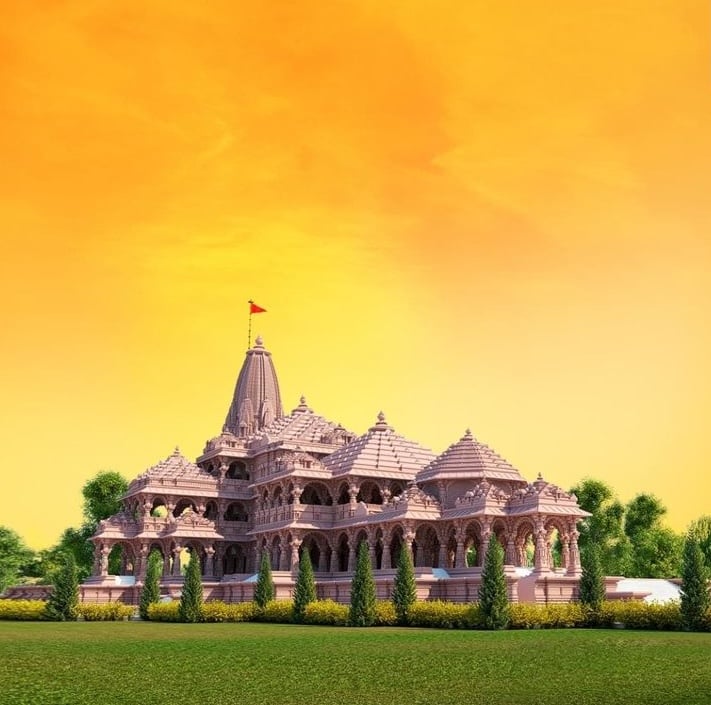Celebrating Ayodhya – A Symbol of Sanātana Dharma
Ayodhya is re-emerging from destruction and neglect, epitomizing the eternal nature of Sanātana Dharma. The upcoming consecration at Ram Lalla Mandir after 550 years is bringing immense joy to the city and nearly a billion Hindus across the world.
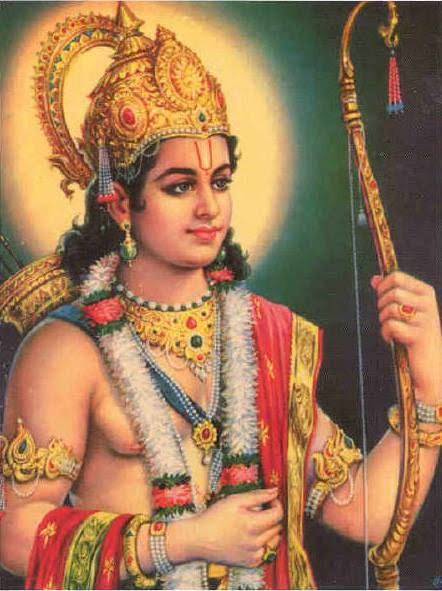
Śri Rāma – Vigrahavān Dharma
Celebrating Ayodhya – A Symbol of Sanātana Dharma
The Personal Connection
My parents named me Kalyanaraman, hoping and praying that some small fraction of Bhagavān Śri Rāma’s qualities and character may manifest in me. However, before I could fully understand the significance of that name, during my first visit to the USA, I changed it to better suit the Western tastes. Similar aspirations as my parents' were perhaps held by those of notable individuals such as E. V. Ramasami Naickar, Ramachandra Guha, N. Ram, Jairam Ramesh, Sitaram Yechury, and Bhimrao Ramji Ambedkar, who may have also desired a glimpse of Rama in their sons. It is important to acknowledge that not all prayers are answered, and in hindsight, in some of these cases, the answer was a resounding "No." Nevertheless, our history has also witnessed the presence of illustrious figures like Ramakrishna Paramahamsa, Ramana Maharishi, Ram Swaroop, Sitaram Goel, Srinivasa Ramanujan, and C.V. Raman, where the answer to their parents' prayers was a "Yes", even if it is a partial Yes.

The Clash of Two Ideas
In the present times, there exists a clash between India and Bharat, each representing two dominant and distinct ideas of India, being played out in the grand stage of India’s political battleground – its modern-day Kurukshetra. On the one hand, there is the idea that the entire civilizational heritage of India, encompassing its spirituality, religion, culture, and traditional wisdom, indeed its Sanātana Dharma (eternal law) is an unnecessary burden, irrelevant and detrimental to India’s progress. A natural corollary of this idea is the notion that India is better off forgetting its past, and must focus on modernizing and westernizing as quickly as possible. A consistent and deliberate effort, to engineer this “forgetting of the past”, has been made as a critical political project for many decades now; with the disconnection of the people from their language, Sanskrit, serving as one of the significant pillars. As individuals became increasingly alienated from their own culture and heritage, they developed an indifference, and even disdain, and grew to look down at their past, their parents, and ancestors. This disdain soon came to be considered a precondition for progress. This was the idea of India that I imbibed through my education at school and college, during my time as a student in India.
On the other side is the idea, which propounds that the country's future cannot be de-linked from its civilizational past, and rely solely and entirely on imitating the latest Western fashions and fads. That its future must be rooted in a meaningful recovery of the wisdom embedded in its ancient culture, its traditions, and civilizational heritage. Recognizing and embracing that such a meaningful revival of India’s civilizational past—its “Dharma” or law which is "Sanātana'' or eternal—as necessary for its own self-respect, sense of identity and destiny, is the alternate idea of Bharat. This perspective unfolded for me only gradually. The realization that this recovery of the past and restoration of Bharat's Hindu heritage is not antithetical to its progress and does not constitute a regression, was not easy for me. I did not arrive at this understanding in one dramatic moment of explosive illumination, but rather the idea grew on me over time. Many Gurus and Acharyas contributed to this gradual understanding – Swami Dayananda Saraswati of Arsha Vidya Gurukulam being a central figure in that journey from darkness to light, from ignorance to knowledge. Just as the “forgetting” of India’s past was meticulously orchestrated, over many decades and perhaps even centuries, the “remembering” of India’s culture, wisdom, and civilizational heritage must also be consciously and diligently engineered. It cannot be left to the happenstance of accident, good fortune, or fate. And we all have a role to play here. To arrive at this understanding, I had to unlearn the previous idea of India that I had already deeply assimilated.
The Watershed Event and Pivotal Turning Point
In late 1992, I was a student at Ohio State University when the Babri Masjid was brought down. Like many poorly informed Hindus, I too was upset, and felt deeply disappointed with my fellow Hindus for having brought down the Babri Masjid. "It is not in our Hindu ethos or character to tear down a religious site of another religion, even if they had done it to us many times over”, I reasoned. I was filled with questions – “Why can’t we construct a Ram Mandir at a nearby site instead?” “Why do we have to claim that exact site for the Ram Mandir?” “Why do we need to stoke this controversy? Why can’t we be secular and work extra hard to get along with the Muslims?”
However, my perspective shifted after I came across the books Hindu Temples – What Happened to Them – Volume 1 and Volume 2. These books changed my thinking. I hold my encounter with these two “Rams” i.e., authors Śrī Sita Ram Goel, and his mentor Śrī Ram Swaroop, to be pivotal moments in my intellectual journey. I then went on to read another book by Śrī Sita Ram Goel titled How I Became a Hindu and one by Śrī Ram Swaroop titled On Hinduism – Reviews and Reflections. Until then, I had never heard about these two “Rams.” Their works left a profound impact on me and after this encounter, I couldn’t stop reading them. I highly recommend reading their books, and for those who have not read them, I have shared their links here. We must note with gratitude that the parents of both these authors had named them after the Bhagavān Śri Rāma.
The Symbiotic Juxtaposition
Vikās (development) and Virāsat (heritage) had always been pitched against one another in the old Idea of India. The current Prime Minister of India, Sri Narendra Modi, changed the rules of the game and showed us that Vikās (Development) does not have to be antithetical to Virāsat (Heritage). He taught us, and is still teaching, this invaluable and unforgettable lesson, through his ideas, his actions, and his accomplishments. It is unclear which of these he is more passionate about – Vikās or Virāsat. I must say here, that it was not entirely clear to me that this integration of Vikās and Virāsat was even possible. I often used to wonder, if a commitment to restore and recover our civilizational past, also invariably meant that we sacrifice a little in the realm of material progress i.e., in the general direction of modernization and westernization.
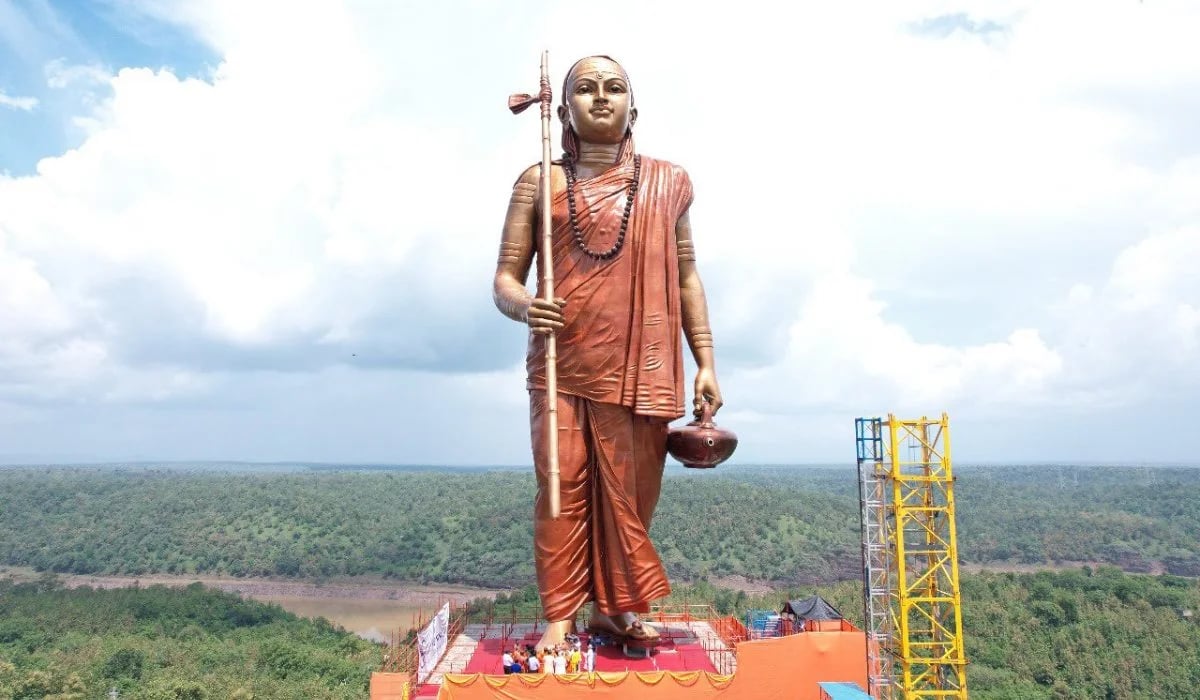 108 ft tall Statue of Oneness at Omkareshwar, Madhya Pradesh
108 ft tall Statue of Oneness at Omkareshwar, Madhya Pradesh
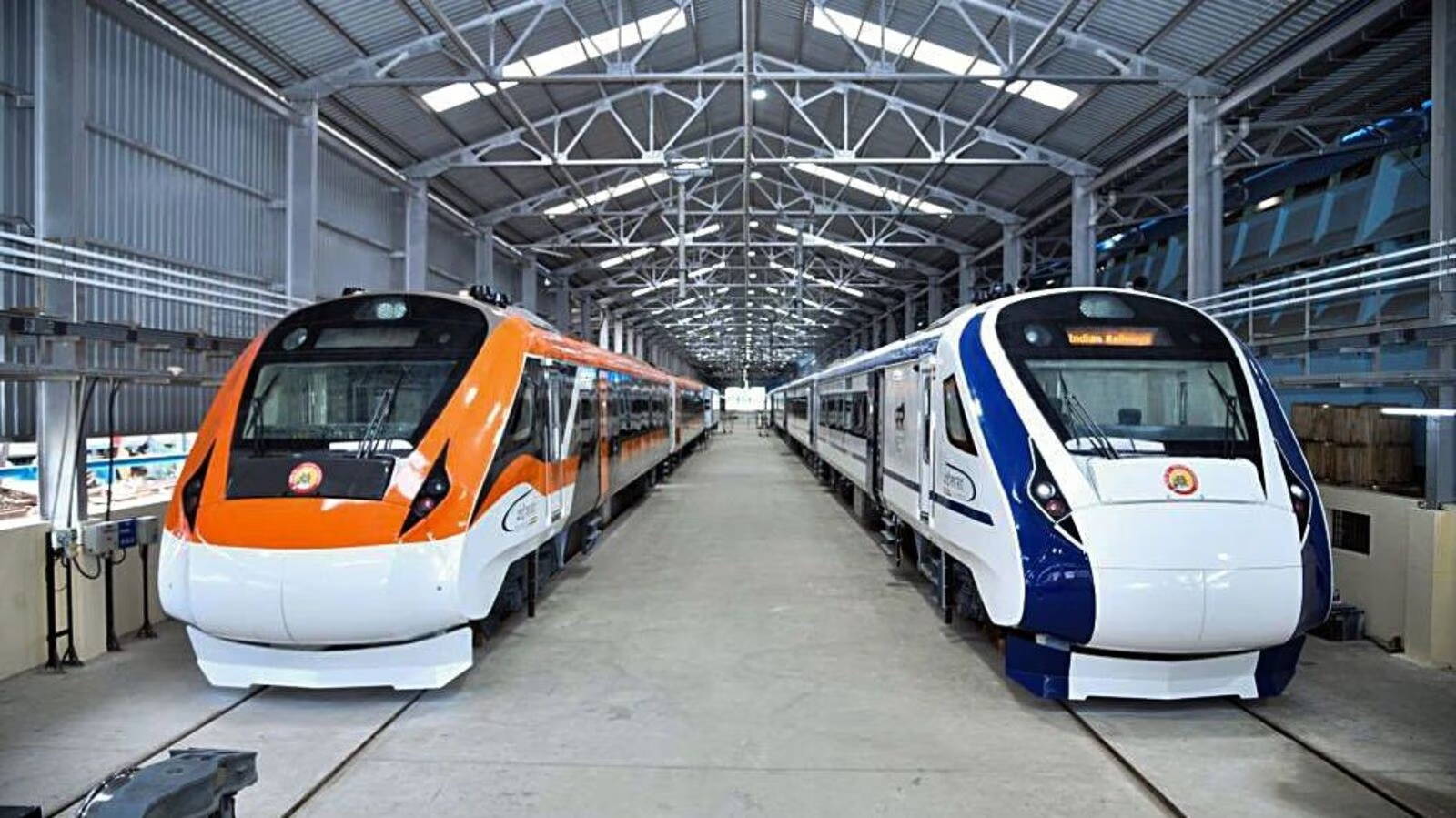
Hi-Tech Vande Bharat Trains
However, the events that have unfolded in Bharat in the last ten years have shown otherwise. One day, Bharat inaugurates yet another of its latest Vande Bharat Railway Trains; and a few days later, it consecrates a newly created Kashi Vishwanath Mandir Corridor. One day, Bharat lands its Lunar mission Chandrayaan on the moon at a location where it has never been done before; a few days later, it inaugurates a newly refurbished Mahakaleshwar Temple Corridor. One day, Bharat celebrates completing nine billion Digital Payment transactions in one month; and a few days later it unveils a 108-foot Statue of Adi Shankaracharya at Omkareshwar. One day Bharat throws open its longest over-sea trans-harbor bridge from Mumbai to Navi Mumbai; and a few days later, the same Bharat is set to consecrate its Ram Lalla Mandir after a five-hundred-year wait in Ayodhya. We can go on with the examples. Prime Minister Narendra Modi is changing the grammar and structure of the democratic politics of India as we speak. He has moved it beyond family, caste, corruption, and appeasement, and created a new possibility – 'Vikās with Virāsat'. He has overturned the Nehruvian idea that Vikās can come only at the expense of Virāsat and vice-versa. And the Nehruvians are in a state of shock now.
Chandrayaan III – The only Lunar Mission to land on the dark said of moon
Atal Setu – India's Longest Sea Bridge
Ayodhya – A Testament
Ayodhya is a testament to this unique synthesis of Vikās and Virāsat. The whole city is re-emerging from a state of longstanding destruction, neglect, and abandonment. The Mandir is rising again, and is bringing in its wake a brand new airport, a new railway station, new trains, new facilities, and in time, new hotels, and other infrastructure will also emerge. The whole economy of the region is awaiting an impending transformation. When Rama returned to Ayodhya after his 14-year exile and numerous travails, the whole of Ayodhya lit up in joy. Now, when the Ram Lalla Mandir rises again in Ayodhya after its 500-year symbolic exile, Ayodhya will light up once more with unspeakable joy.
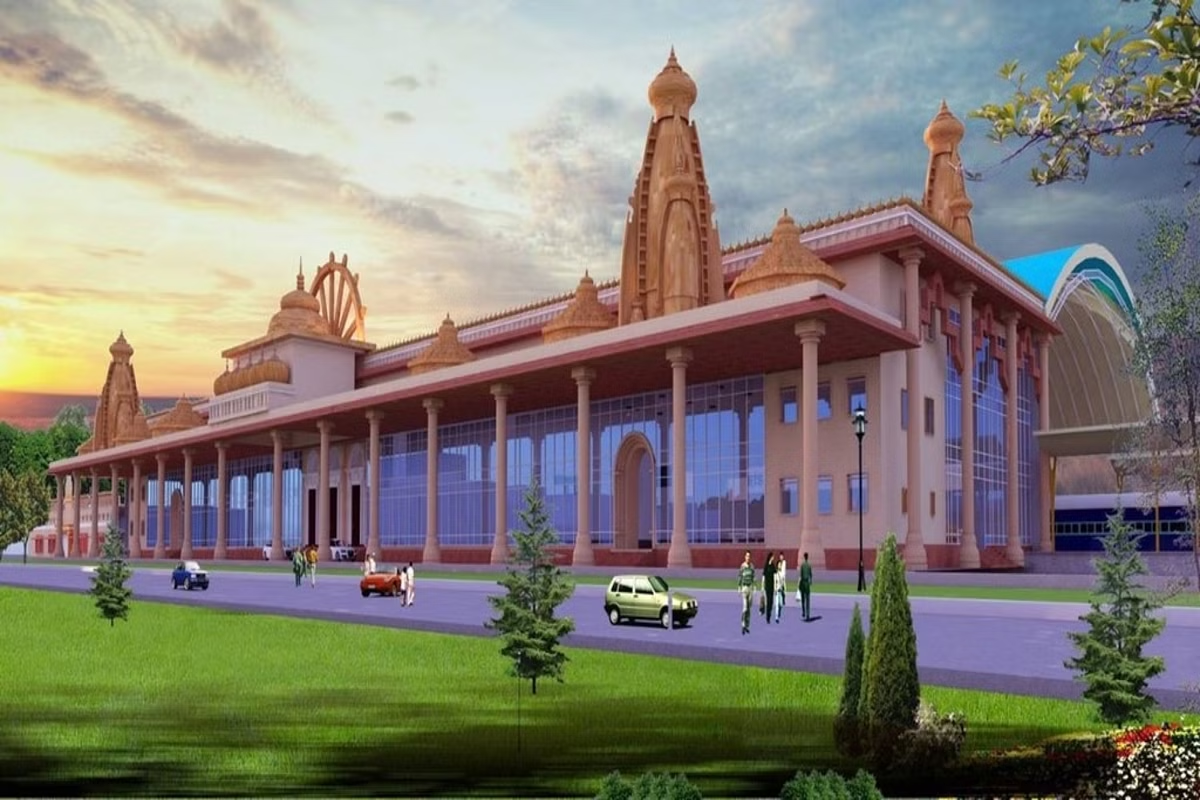 The proposed uplift of Ayodhya Railway Station underway
The proposed uplift of Ayodhya Railway Station underway
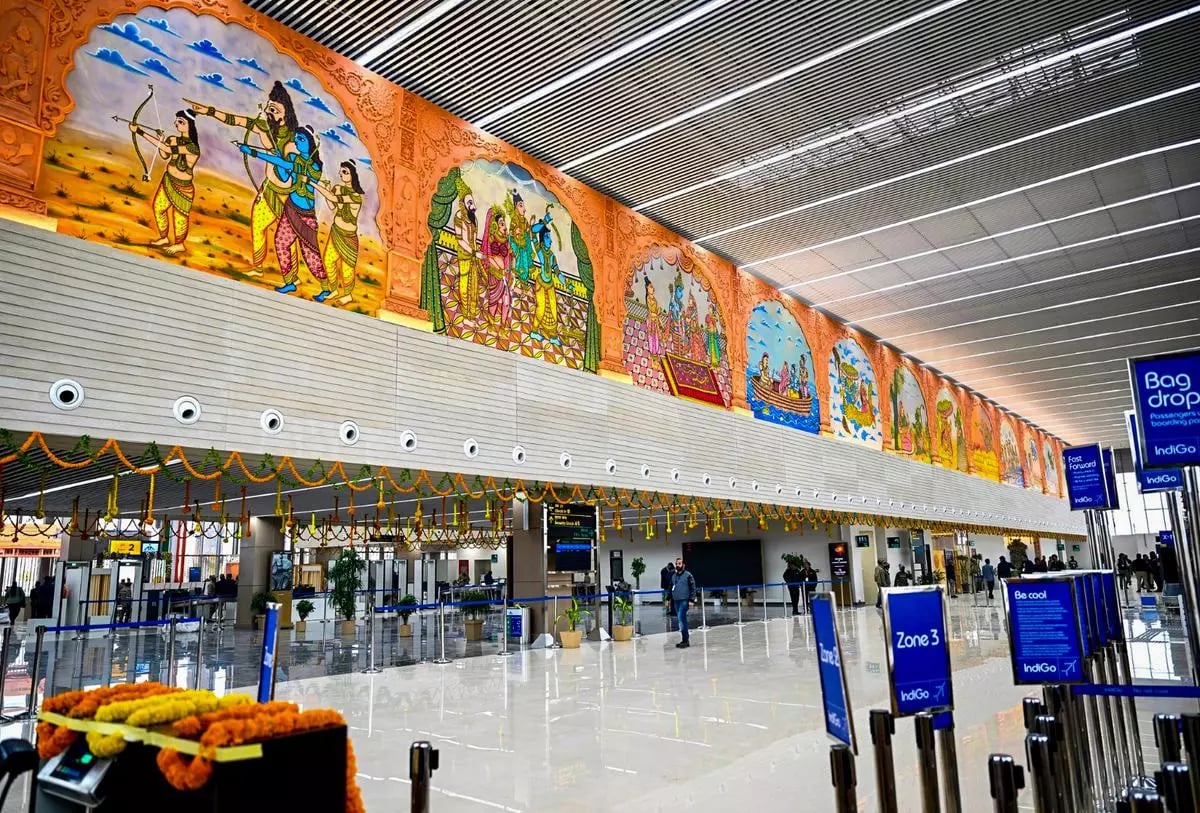
Interiors of the Maharishi Valmiki International Airport, Ayodhya
A Civilization is waking up from its slumber. Dharma is awakening. This potential for rebirth, for re-emergence, is what makes it ‘Sanātana’ or eternal. Rāma is simultaneously eternal and undying in his Ādhyātmika dimension; He is the Avatāra of Viṣnu in his Ādidaivika dimension as a Vigrahavān Dharma; He is a great example for us all to emulate, as a human Hero in his Ādibhautika dimension. It is the Spirit of Sanātana Dharma that is re-emerging once more in Ayodhya.
The Rām Lallā Vigraha to be consecrated at Ayodhya
We at Hindu University of America stand with Prime Minister Modi and the billion-plus Hindus all over the world, those who believe and stand ready to rejoice, and those who are confused and don’t know what to do about this phenomenon, to celebrate with gratitude this ceremony consecrating the Rām Lallā deity in this newly built Rām Mandir, on January 22, 2024.
May it be a day when we Hindus remember our past once more with both joy and pride and contemplate our future with confidence and clarity.
Jai Śrī Rāma!



